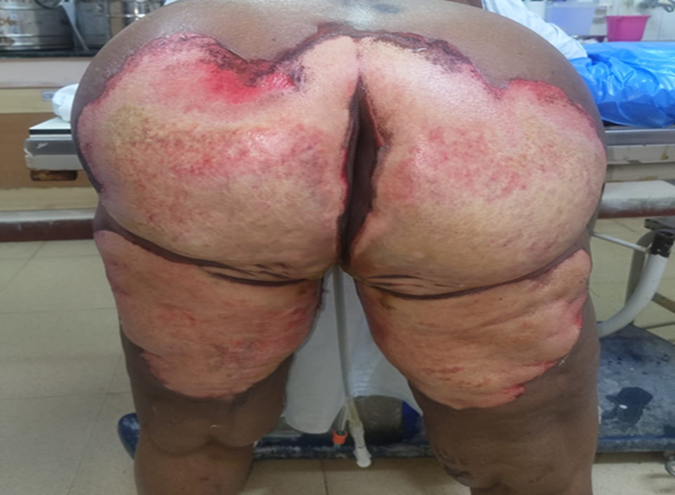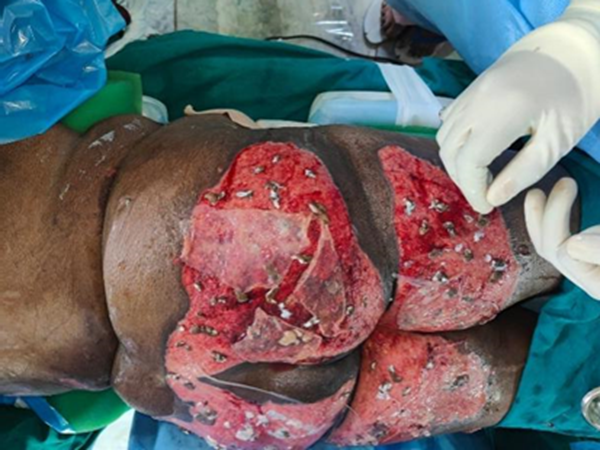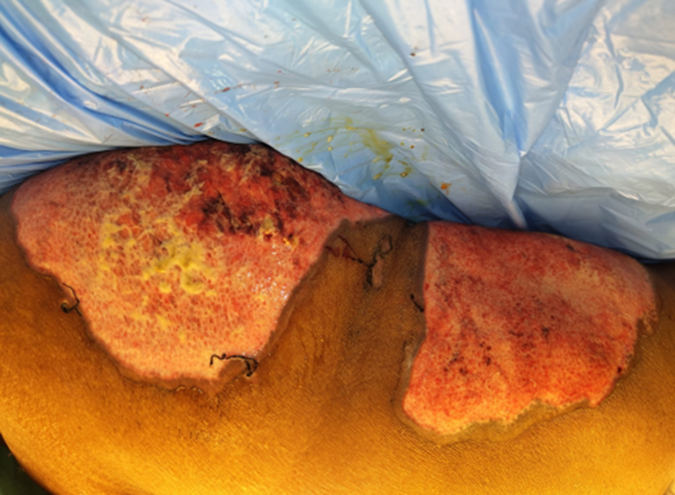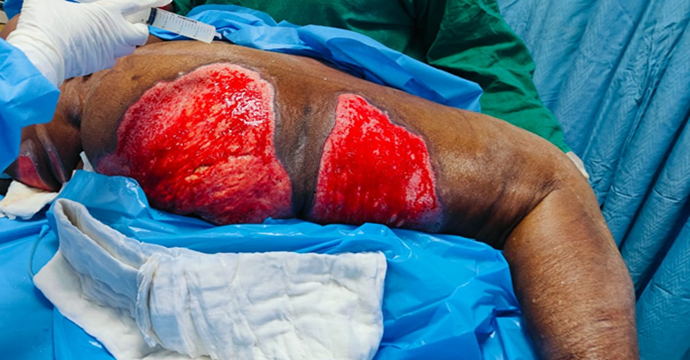Current Issue : Article / Volume 3, Issue 1
- Research Article | DOI:
- https://doi.org/10.58489/2836-2330/019
The Significance of Super Oxidized Solution in Thermal Burns Wound Management
- MBBS, MS Orthopaedics surgery, Junior Resident, Department of Orthopaedic Surgery, JIPMER, Puducherry, India.
- MCh, DNB, MNAMS, FRCS (Edin), DSc, PhD (Plastic Surgery), Professor & Registrar (Academic), Head of IT Wing and Telemedicine, Department of Plastic Surgery & Telemedicine, JIPMER, Pondicherry, India.
- MBBS, MS DNB General Surgery, Senior Resident, Department of Plastic Surgery, JIPMER, Puducherry, India
- MBBS MS General Surgery, Senior Resident, Department of Plastic Surgery, JIPMER, Puducherry, India
- MBBS, MS DNB General Surgery, MCh Plastic Surgery, Assistant Professor, Department of Plastic Surgery, JIPMER, Puducherry, India
Ravi Kumar Chittoria
Karthikeyan, Ravi Kumar Chittoria, Kanav Gupta, Jacob Antony Chakiath, Padmalakshmi Bharathi Mohan. (2024). The Significance of Super Oxidized Solution in Thermal Burns Wound Management. Journal of Clinical and Medical Reviews. 3(1); DOI: 10.58489/2836-2330/019
© 2024 Ravi Kumar Chittoria, this is an open-access article distributed under the Creative Commons Attribution License, which permits unrestricted use, distribution, and reproduction in any medium, provided the original work is properly cited.
- Received Date: 10-05-2024
- Accepted Date: 01-06-2024
- Published Date: 03-06-2024
Superoxidized solution, thermal burns, wound management
Abstract
Proper dressing and preparation of thermal burns wounds are vital not just for infection prevention but also for potential surgical intervention. This article discusses our evaluation of the efficacy of Super Oxidized Solution in locally treating thermal burns wounds. In the case report performed on a 70-year-old female with thermal burns over the gluteal region, Super Oxidized Solution facilitated wound healing and prepared wounds for definitive coverage by promoting granulation and reducing infection, which are the prerequisites for surgery.
Introduction
Various agents such as Povidone Iodine, EUSOL, Acetic acid, hydrogen peroxide, Silver sulfadiazine, and local antibiotic ointments have traditionally been employed in managing thermal burns [1]. These dressings serve the purpose of preventing infection, reducing bacterial load, and promoting granulation to facilitate wound healing. The utilization of Super Oxidized Solution represents a novel approach to wound management. This solution, characterized by a hypotonic nature with an osmolarity of 13 mOsm/kg, contains components like Hypochlorous acid, Sodium hypochlorite, Chlorine dioxide, Ozone, Hydrogen peroxide, and Sodium chloride. Manufactured through an electrochemical process involving pure water and sodium chloride, Super Oxidized Solution generates reactive oxygen and chlorine species during electrolysis. These released species disrupt the cell membrane's integrity, leading to lipid and protein denaturation in single-celled organisms due to osmolarity imbalances. Unlike single-celled organisms, multicellular organisms are less susceptible to such osmolarity changes [2].
Materials and Methods
In this study, a 70-year-old female with 15% thermal burns over bilateral gluteal region (Figure 1, 4) was enrolled and managed at the Department of Plastic Surgery, JIPMER, Puducherry, India.
She underwent thorough clinical examination, and essential investigations such as Hemoglobin, Total Count, Differential Count, Bleeding Time, Clotting Time, Erythrocyte Sedimentation Rate, Random and/or Fasting Blood Sugar, Serum Creatinine, Blood Urea, HIV, HBsAg, and Complete Urine Examination were conducted to assess anesthesia fitness and rule out underlying systemic conditions. Additionally, wound swabs were cultured to identify the type of organism and its antibiotic sensitivity.
The wounds received daily irrigation with Super Oxidized Solution (Figure 2) and were dressed with gauze soaked in the same solution. Blood sugar levels were regulated using insulin and/or oral hypoglycemic drugs, with input from an endocrinologist in all cases.
The wounds responded to treatment with Super Oxidized Solution, and exhibited healthy granulation following local treatment with Super Oxidized Solution. As the wound bed condition improved, it facilitated performing skin grafting (Figure 3). The study documented the status of bacterial growth, time required for wound sterility, granulation appearance, healing duration, and any associated complications.





Results
Wound healing was found to be hastened by application of super oxidized solution, proving the efficacy of using superoxidized solution in treatment for wound healing. The condition of the wounds improved following utilization of super oxidised solution regularly. The wound score improved from 48 to 32 (Figure 4, Figure 5).
Discussion
The prevalence of thermal burns is quite high, such as accidental, self-inflicted, etc., Managing thermal burns and its complications requires a multidisciplinary approach, as it affects various organs and systems in the body. Thermal burns wounds pose a significant challenge to clinicians in their everyday practice and have historically been treated with various local dressings and agents [3].
Super Oxidized Solution represents a newer approach to wound management. It has been investigated by researchers worldwide as a disinfectant for instruments and has been used on humans for various indications, including ulcers, mediastinal irrigation, peritoneal lavage, and hand washing [4,5]. Approved by the European CE KEMA as a Medical Device Class IIb in 2004 and by the FDA in 2005, this solution has garnered positive results in wound management across various etiologies, with no reported reactions or complications in the literature [6].
In our study, we focused on thermal burns wounds and utilized Super Oxidized Solution for cleansing and sterilization. Our sample included patients of all age groups, with a predominance of males. Following 5 days of Super Oxidized Solution application, the wound achieved sterility followed by which full thickness skin grafting surgery was performed. This definitive procedure was undertaken once the wounds exhibited sterile conditions and healthy granulation following Super Oxidized Solution application.
Consistent with previous literature, our study found no noticeable complications associated with the use of Super Oxidized Solution [7-11]. This solution aids in debriding necrotic tissue, reducing microbial load, promoting granulation, and accelerating healing time without causing harm to normal tissue. For patients with small superficial ulcers or those unsuitable for definitive surgery, conservative management with Super Oxidized Solution alone may be sufficient. The moisturizing effect and minimal toxicity of Super Oxidized Solution make it a favorable option for managing thermal burns ulcers. However, further controlled trials are needed to fully elucidate its antimicrobial, anti-inflammatory, and wound-healing effects.
Conclusion
Super oxidized solution proves beneficial in promoting wound healing in across a spectrum of cases, regardless of whether they are acute or chronic and irrespective of their underlying causes. Its utility extends to burn injuries as well as within the realm of cosmetic surgery. Our case report findings affirm that super-oxidized solution contributes to enhanced wound healing across diverse wound types.
References
- Tanaka, N., Tanaka, N., Fujisawa, T., Daimon, T., Fujiwara, K., Yamamoto, M., & Abe, T. (2000). The use of electrolyzed solutions for the cleaning and disinfecting of dialyzers. Artificial organs, 24(12), 921-928.
- Nelson, D. (2000). Newer technologies for endoscope disinfection: electrolyzed acid water and disposable-component endoscope systems. Gastrointestinal Endoscopy Clinics of North America, 10(2), 319-328.
- Park, H., Hung, Y. C., & Kim, C. (2002). Effectiveness of electrolyzed water as a sanitizer for treating different surfaces. Journal of food protection, 65(8), 1276-1280.
- Inoue, Y., Endo, S., Kondo, K., Ito, H., Omori, H., & Saito, K. (1997). Trial of electrolyzed strong acid aqueous solution lavage in the treatment of peritonitis and intraperitoneal abscess. Artificial Organs, 21(1), 28-31.
- Sakashita, M., Iwasawa, A., & Nakamura, Y. (2002). Antimicrobial effects and efficacy on habitually hand-washing of strong acidic electrolyzed water--a comparative study of alcoholic antiseptics and soap and tap water. Kansenshogaku zasshi. The Journal of the Japanese Association for Infectious Diseases, 76(5), 373-377.
- Meschter C. Safety and Efficacy of Treatment for Cutaneous wound study. Comparative Biosciences, Inc. Study Number, 2005: 8212-04.
- Yahagi, N., Kono, M., Kitahara, M., Ohmura, A., Sumita, O., Hashimoto, T., ... & Takamoto, S. (2000). Effect of electrolyzed water on wound healing. Artificial organs, 24(12), 984-987.
- Landa-Solis, C., González-Espinosa, D., Guzmán-Soriano, B., Snyder, M., Reyes-Terán, G., Torres, K., & Gutierrez, A. A. (2005). MicrocynTM: a novel super-oxidized water with neutral pH and disinfectant activity. Journal of Hospital Infection, 61(4), 291-299.
- Sekiya, S., Ohmori, K., & Harii, K. (1997). Treatment of infectious skin defects or ulcers with electrolyzed strong acid aqueous solution. Artificial Organs, 21(1), 32-38.
- Dalla Paola L, Brocco E, Senesi A et al. use of Dermacyn, a new antiseptic agent for the local treatment of diabetic foot ulcers. J Wound Healing 2005; 2: 201.
- Dang, C. N., Prasad, Y. D. M., Boulton, A. J. M., & Jude, E. B. (2003). Methicillin‐resistant Staphylococcus aureus in the diabetic foot clinic: a worsening problem. Diabetic Medicine, 20(2), 159-161.


